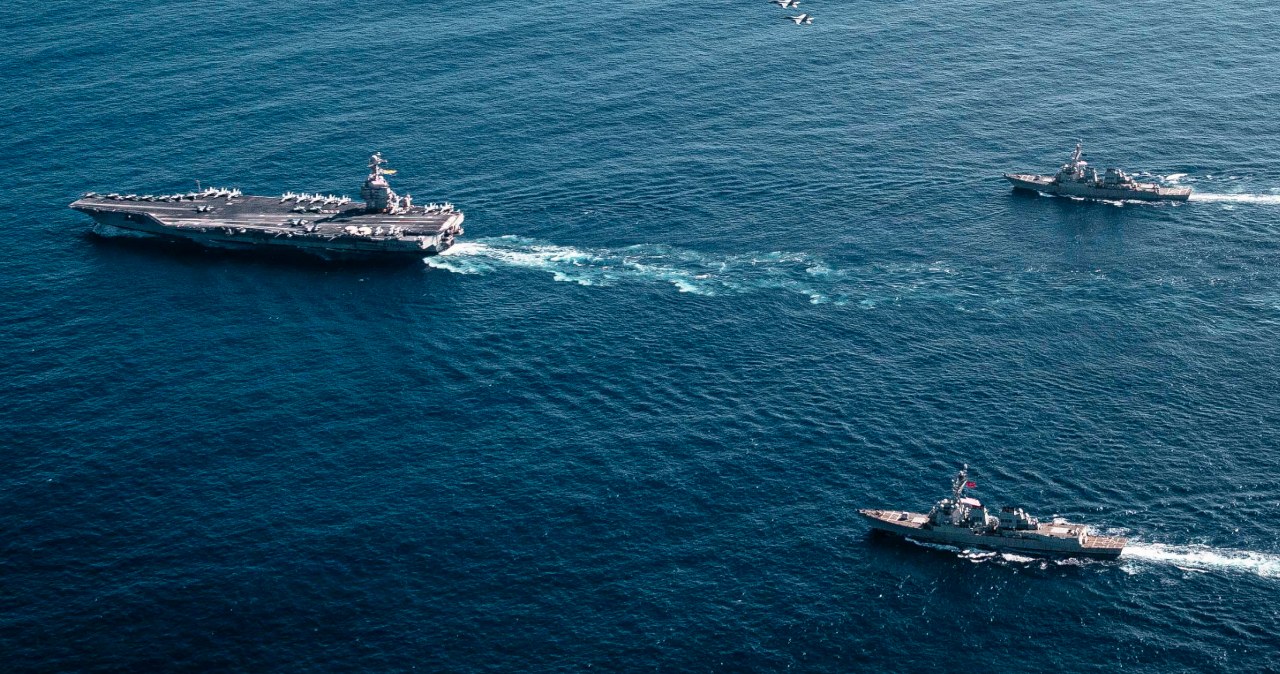![]()
США нанесут удар по Ирану? Стратегический рубикон Трампа, точный гамбит Израиля и расчетная игра Китая
Автор: Тамуз Итай, The Epoch Times
Незадолго до рассвета 13 июня Израиль начал операцию «Восходящий лев», свою крупнейшую воздушную кампанию, развернув более 200 истребителей скоординированными волнами, которые сбросили более 330 боеприпасов по меньшей мере на 100 стратегических целей по всему Ирану. Пилотный завод по обогащению топлива в Натанзе, жизненно важный для размещения около 1700 центрифуг IR4 и IR6, способных обогащать уран до уровня оружия, сильно пострадал. Израиль также нанес удары по дополнительным ядерным объектам вблизи Эсфахана, Арака, Фордо, Парчина и нескольких баз КСИР — свидетельство тщательно откалиброванной кампании, призванной подорвать ядерные амбиции Ирана.

Но не каждая крепость пала.
Глубоко погребенный объект Фордо, защищённый под сотнями футов скалы, остается нетронутым, вне досягаемости израильского арсенала.
Именно этот разрыв вызвал срочные разговоры в Вашингтоне: Должны ли Соединенные Штаты теперь вывести свой GBU57 Massive Ordnance Penetrator, 15-тонный бункер-бастер, предназначенный для проникновения в затвердевшие подземные объекты?
Когда точность сталкивается с политическими расчетами
Иран ответил почти сразу, выпустив более 150 баллистических ракет и 100 беспилотников на израильскую территорию. Железный купол и противовоздушная оборона союзников нейтрализовали основную часть этой угрозы, лишь часть которой нарушила щит, нанеся ограниченный, но символический ущерб. Представители разведки США сообщили, что Иран потратил почти четверть своих ракетных запасов, первоначально оцениваемых в 2000-3000, всего за несколько дней, что свидетельствует о его убывающей мощности.
Президент Трамп, который весной поставил 60-дневный срок, требуя, чтобы Иран сократил свои ядерные устремления, стоит перед выбором. По данным The Wall Street Journal, он в частном порядке одобрил военные варианты, включая удары США, но при этом держит руку на общественной арене, поддерживая Израиль посредством развертывания противоракетной обороны и региональных сил, воздерживаясь от окончательных заказов. Позиция Трампа не агрессивна по импульсу — она измеряется намерением. Его послужной список говорит о том, что он скорее против неудач, чем против действий, готов действовать решительно, но только с обещанием долгосрочных результатов.
Бункеры, бомбы и бремя того, что будет дальше
Это одна из проблем, связанных с отправкой бункерных бустеров; другая — представить последствия. Если удару США удастся уничтожить Фордо, возникает вопрос: Что заполняет вакуум, который он оставляет?
Один оптимистический сценарий, упомянутый некоторыми, сосредотачивается на Резе Пехлеви, сыне шаха, возможно, возвращающемся в качестве переходной фигуры. Внутренний реформатор, имеющий связи с умеренными эмигрантами, Пехлеви мог бы заложить основу для ориентированного на Запад управления, экономического восстановления и, возможно, даже региональной архитектуры мира, напоминающей Абрахамские соглашения. Но оптимизм должен быть сдержанным. После свержения Саддама Хусейна в Ираке страна развалилась на сектантскую войну и воинственную фрагментацию, породив ИГИЛ, а затем и иранское влияние — отрезвляющие последствия авторитарного краха. Иран, несмотря на все свои недостатки, сохраняет более сильную институциональную и историческую согласованность. В отличие от Ирака, который был новой страной, Иран имеет многовековую общую историю.
Тем не менее, признаки стресса очевидны: в Тегеране наблюдается массовая эвакуация; экономика балансирует под тяжестью санкций и общественных беспорядков; и правящая элита, уже потрясенная потерями в Натанзе и других местах, кажется разделенной. Оставленный неуправляемым, этот перелом может породить вооруженные ополченцы — некоторые с контролем над ядерными или радиологическими материалами — поднимая призрак «грязных бомб», которые угрожают глобальной безопасности.
От теней до неба: мастер-инсульт израильской разведки
Что поднимает операцию «Восходящий лев» от тактического удара до оперативного чуда, так это архитектура разведки, лежащая в ее основе. Все части готовились годами. В течение нескольких месяцев Моссад закладывал взрывоопасные беспилотники, саботировал радары и направлял полезную нагрузку в Иран — стратегию, которую Bloomberg описывает как «гибридную войну par excellence». Создание агентством наземной базы беспилотников, которая, как полагают, находится в центральных провинциях Ирана, позволило точно нейтрализовать ракетные пусковые установки и средства противовоздушной обороны.
Высококачественные платформы, в том числе истребители F-15I Ra’am «Thunder», оснащенные 2000-фунтовыми бункерами BLU109, дополняют скрытные миссии F35I Самолеты Adir, поддерживаемые дозаправкой в воздухе и передовыми израильскими мишенями. Синергия между скрытой человеческой разведкой, кибероперациями, беспилотниками и пилотируемыми самолетами переопределила верхние пределы современной высокоточной войны.
Скрытые расходы: инвестиции Китая на Ближний Восток на миллиард долларов
На фоне геополитических потрясений Пекин смотрит не с праздной отстраненностью, а с корыстным интересом. 25-летнее китайско-иранское стратегическое партнерство в марте 2021 года, оцениваемое в 300-400 миллиардов долларов, связывает Китай с устойчивыми инвестициями в энергетический, телекоммуникационный, транспортный и потенциально военный секторы Ирана.
Для Китая Иран служит нескольким целям:Это санкционированный источник нефти (позволяющий КПК покупать нефть дешевле), плацдарм для ближневосточной геополитики и рычаг для отвлечения и разделения Запада. Если иранский режим полностью рухнет, Китай потеряет этот рычаг, но если страна расколется, Пекин будет эксплуатировать фрагментированное государство и воздвигнет новый плацдарм, так же, как и после ухода США из Афганистана.
Перекресток Америки: стратегия над шоуменством
Самым серьезным просчетом было бы рассматривать предстоящие действия США как еще один самостоятельный военный удар. Речь идет не о острых ощущениях от подрыва бункера - он омрачен императивом предвидения. Планировщики США должны спросить: У нас есть жизнеспособная политическая дорожная карта? Можем ли мы управлять после забастовки? Соответствуют ли наши союзники и международное сообщество принципам восстановления или стабильности переходного периода? Важно, можем ли мы помешать Пекину извлечь выгоду из последствий?
Это не гипотетические вопросы — это стратегическая архитектура современного вмешательства, и я предполагаю, что за прошедшую неделю администрация США была занята за кулисами, разрабатывая эти сценарии и обращаясь к союзникам и другим.
Оригинальное название: Legacy Wears the Blueprint, Not the Bomb
Грядущее решение — сбросить бункеровщики на Фордо — будет эхом для поколений. Чисто кинетическая победа, которой не хватает, рискует превратить тактический успех в стратегическую ответственность. Хуже того, он может подарить Пекину новое полотно влияния в тот момент, когда Запад стремится остановить его экспансию.
Президент Трамп — или любой американский лидер — сталкивается с редким моментом стратегического перекрестка: сбросить бомбы, да, но также разработать план для следующей главы Ирана. Победа без видения пуста. Только с обоими из них сегодняшняя миссия может перейти в долгосрочное наследие.
Мнения, выраженные в данной статье, являются мнениями автора и не обязательно отражают взгляды ZeroHedge.
Тайлер Дерден
Сат, 06/21/2025 - 23:20





![Śmiertelny wypadek na DK36. Policjanci zatrzymali podejrzanego o spowodowanie tragedii [WIDEO]](https://storage.googleapis.com/poludniowaoficyna-pbem/zwielkopolski24/articles/image/562dffb6-376b-4ffa-b37c-c25f2f0c2f3f)



![Najciemniej pod… kamerą? Nad zalewem trwa walka z wiatrakami [FOTO]](https://swidnica24.pl/wp-content/uploads/2025/11/page-5.jpg)


![Ćwiczenia dowódczo-sztabowe "Ewakuacja 2025" odbyły się w urzędzie marszałkowskim [ZDJĘCIA, WIDEO]](https://static.olsztyn.com.pl/static/articles_photos/45/45308/8a094ad54a14638397531e3d195ca470.jpg)